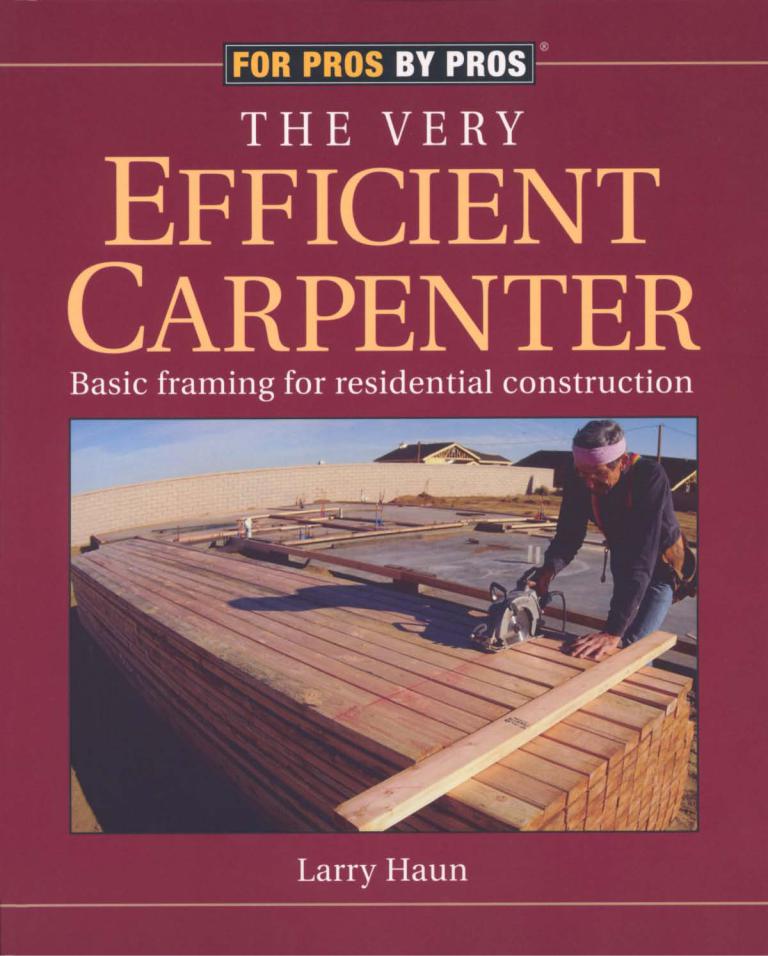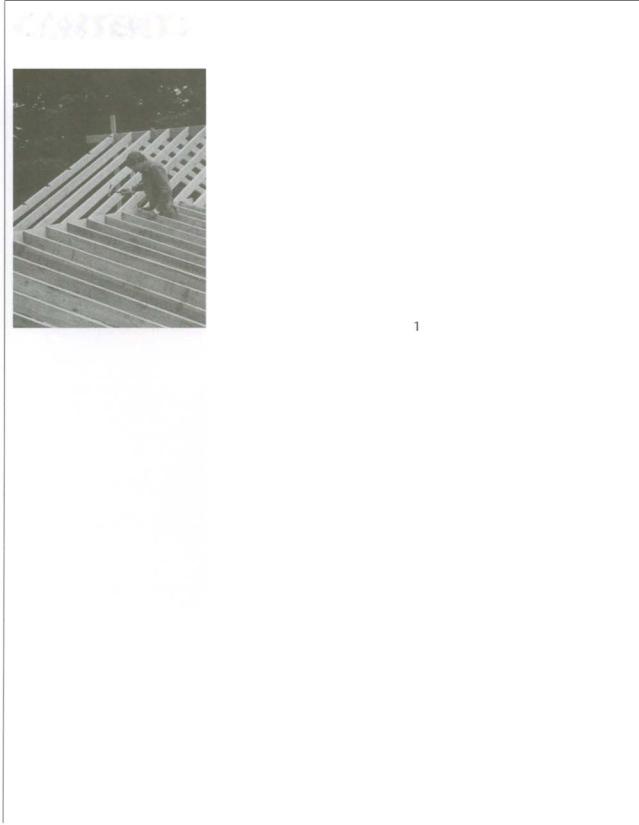
Haun_Larry_-_The_very_efficient_carpenter
.pdf
THE VERY
EFFICIENT
CARPENTER ----



Cover photos: Larry Hammerness
© 1998 by The Taunton Press, Inc. All rights reserved.
Printed in the United States of America 10 9 8 7 6
For Pros / By Pros®: The Very Efficient Carpenter was originally published in 1992 by The Taunton Press, Inc.
For Pros / By Pros® is a trademark of The Taunton Press, Inc., registered in the U.S. Patent and Trademark Office.
The Taunton Press, Inc., 63 South Main Street, PO Box 5506, Newtown, CT 06470-5506 e-mail: tp@taunton.com
Library of Congress Cataloging-in-Publication Data
Haun, Larry. |
|
|
For Pros / By Pros®: The very efficient carpenter : |
||
basic framing for residential construction / |
||
Larry Haun. |
|
|
p. |
cm. |
|
Includes index. |
|
|
ISBN 1-56158-326-X |
|
|
1. House framing. I. Title. |
|
|
TH2301.H38 1998 |
92-12644 |
|
694'.2-dc20 |
CIP |
|

ACKNOWLEDGMENTS
As a carpenter and a teacher of carpenters, I have long seen the need for a different approach to teaching frame carpentry. That's why I decided to write this book and to make the companion videos. The list of those who helped along the way is long. Here's thanks to those who gave more than a little help.
The many people at The Taunton Press who gave me enthusiastic encouragement.
Jeff Beneke, my editor, who asked a million questions and shortened, clarified and added to the quality of the text.
My wife, Mila, and daughters Ninay and Risa, who helped with duplicating, computer problems and love.
My brothers Jim and Joe and my sisters Margaret and Loretta, for technical help and encouragement.
Bill Mauger, who taught me about video and how to work before a camera.
Jim Hall and his video crew, Jeff Fay and Tim Olson. Hard workers, all.
Roger Turk and my son Eric, for their photographic work.
Creighton Blenkhorn, director of VBC apprenticeship training in southern California, who got me in front of the camera to make training videos for apprentices.
Kelly Adachi, who taught me computer basics.
Joel Foss, OSHA, for information on safety.
Ed Franken, who helped me solve some framing problems.
John Gibson, for the house plans.
My nephew Larry Haun, who saved me when my computer went in unknown directions.
Marty Hittleman, for help with math.
Milt Rosenberg, building inspector, for technical help.
Jane Tokunow, for reading and reviewing materials.
This book is dedicated to carpenters and framers everywhere who love the smell and feel of wood and enjoy building houses
that people can turn into homes.

CONTENTS
Introduction |
viii |
4 FRAMING CEILINGS |
1 G ETTING STARTED |
|
joisting for a Gable Roof . . . . . . |
|
joisting for a Hip Roof... . . . . . . . |
127
128
133
Tools . . . . . . . . . . . . . . . . . . . . . . . . . . . . . . . . . . . . . . . . .2
Plans, Codes and Permits . . . . . . .11
Lumber and Materials . . . . . . . . . . .20
|
27 |
2 FRAMING flOORS |
|
Sills . . . . . . . . . . . . . . . . . . . . . . . . . . . . . . . . . . . . . . . |
. .28 |
Posts and Girders . . . . . . . . . . . . . . . . . |
. .35 |
joists . . . . . . . . . . . . . . . . . . . . . . . . . . . . . . . . . . . . . |
. .41 |
Sheathing Floors. . . . . . . . . . . . . . . . . . . |
. .55 |
3 FRAMING WALLS |
63 |
Layout.. . . . . . . . . . . . . . . . . . . . . . . . . . . . . . . . . . |
. .64 |
Plating . . . . . . . . . . . . . . . . . . . . . . . . . . . . . . . . . . |
. .71 |
Headers, Cripples, |
|
Trimmers and Rough Sills . . . . . |
. .79 |
Detailing . . . . . . . . . . . . . . . . . . . . . . . . . . . . . . . |
. . 89 |
Building and Raising Walls . . . |
. .98 |
Plumbing and Lining . . . . . . . . . . . . |
1l6 |
Sheathing Walls . . . . . . . . . . . . . . . . . . . . |
125 |
5 FRAMING ROOFS |
l35 |
Gable Roofs . . . . . . . . . . . . . . . . . . . . . . . . . . |
136 |
Hip Roofs . . . . . . . . . . . . . . . . . . . . . . . . . . . . . . |
159 |
Intersecting Roofs . . . . . . . . . . . . . . . . . |
170 |
Truss Roofs. . . . . . . . . . . . . . . . . . . . . . . . . . . . |
l77 |
Sheathing Roofs . . . . . . . . . . . . . . . . . . . |
183 |
6 BUILDING STAIRS |
189 |
Straight-Flight Stairs . . . . . . . . . . . . . |
190 |
Stairs with a Landing . . . . . . . . . . . . |
200 |
Stairs with a Winder . . . . . . . . . . . . . |
204 |
Index |
209 |

INTRODUCTION
Ithe 1930s, no houses were being built, and I took then rural western Nebraska in
existing ones for granted, much as I did the trees, the hills and the constant wind. They just were. The only type of construction I knew was when my father set some fence posts in the ground, wrapped the perimeter with hog wire both inside and out, and stuffed the middle full of straw to form a wall and give some protection to a milkcow. Only when the high school was remodeled and added to did I begin to realize that buildings had to be brought into existence, that buildings have authors like books. This was a fascinating revelation, one that fascinates me to this day as I see new structures rise up out of the ground.
The carpenters who did that remodeling job came from another town, "over on the river," and wore white overalls with a lot of extra pockets. They carried big toolkits with shiny handsaws, levels, planes, squares, braces and bits, plumb bobs, chisels sharp enough to shave with, little hammers, big hammers, sledgehammers. I especially loved to watch the long curls of wood rising up out of a plane as it was pushed over a surface. I hung around so much that they finally put me to work as a waterboy and general gofer-at 50 cents a day. That summer made a lifelong mark on me.
We had some tools at home, of course: a small handsaw with teeth more rounded than pOinted, a claw hammer with one claw missing, an old nicked wood chisel. There were no power tools because electricity wasn't available in our area. With these basic tools my father kept the animals sheltered, generally using nails salvaged from the sites of burned-down buildings. For my part, I was busy making toy propellers and kite struts from the lids of bushel baskets and the lovely soft wood of orange crates. I remember struggling for hours on end to cut off a piece of wood with the old handsaw. My best tool was a jackknife that I managed to keep somewhat sharp by borrowing a whetstone from a friend. So I was deeply impressed by the beauty and power of the tools those carpenters had. And the smell of their work area as they worked to shape the different woods is still with me. I have smelled it a thousand times since, but that first time was my memory marker.
In 1947, when I was 16, I helped an old carpenter build a house. He was a gentle old man, teaching an apprentice the basics of the trade. With me working in the summer and part time during the school year, it took us almost a year to nail it all together. His tools were sacred, cared for like fine jewelry,carefully wrapped and protected from rust, used with the utmost care and precision. He took great pride in his work, with good reason, for he was as much an artist as a craftsman.
But the postwar world was changing rapidly and leaving him behind.
Out of high school, I needed money for college, so when my brother invited me down to Albuquerque to help him frame houses, I jumped at the chance. Besides needing money, I was ready for a warmer climate. The great postwar housing boom was beginning with lots being cleared and foundations being poured all over town, and any willing worker had a job. We were still inwhite overalls, using only hand tools. As carpenters, we were expected to cut framing lumber with a handsaw, pour foundations, shingle roofs, lath, lay and finish hardwood floors and build cabinets. But as the need for housing increased, this began to change. The age of specialization was rapidly approaching. Builders started trying to apply to construction the mass-production, assembly line techniques that Henry Ford used to build cars.
This was not a matter of decreasing the quality or durability of houses. Building codes became stricter year after year, as they do to this day. Even tougher was the Federal Housing Administration, which separately inspected all the millions of G.!. houses it financed. The old saying, "They just don't build houses the way they used to," is true. For the most part, they build them much better. But the great discovery, not yet fully understood or accepted, is that
